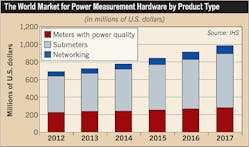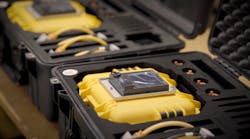Behind their steel, concrete, and glass facades, buildings are pulsating energy hubs. In concert with the highly automated systems that deliver it, that energy can convey a sense that buildings approximate living, breathing organisms. In a sense, they are. Programmed HVAC systems hum around the clock, computer systems labor on, and security systems monitor the premises, even as they remain largely devoid of human life for half the day. Little wonder, then, that in a time of heightened concern with energy conservation, these complex structures with a life of their own — and the actions and decisions of those who own and inhabit them — are inviting more scrutiny.
Buildings, often gluttonous users of energy, are highly visible. As such, they have large bulls-eyes on their backs that attract the aim of anyone with a stake in being on the right side of the energy consumption debate. These days, that’s just about everyone — from politicians and government agencies to climate activists and corporations.
It’s against this backdrop that efforts to better quantify, benchmark, and meter building electrical usage are picking up speed. Across the country, initiatives to collect information on building electrical usage at multiple levels and in myriad ways are advancing.
Some form of improved or more sophisticated “advanced” metering is increasingly central to the effort. Whether you’re talking master meters that record energy usage on a total building level or submeters that monitor electrical consumption at a more granular level, “smarter” metering is emerging as the vital first step to digging deeper into a building’s energy use profile and setting corrective actions into motion (see SIDEBAR 1: Power Measurement Market on the Rise). Behind the push is a mix of motivating factors — from government mandates and grant money to “best practices” guidelines and top-down directives.
Casting a wider net
Seattle has had commercial building metering rules in its energy code since 2010, requiring new buildings larger than 20,000 square feet to install whole-building metering plus submetering for HVAC, hot water, lights, plug loads, and process loads. All of this data is fed to a graphic display in which the building manager can track energy use patterns. In the new code (effective this fall), separate metering will also be required for full-floor tenant spaces. Meanwhile, the code for the rest of Washington State will include a limited set of metering requirements with a threshold of 50,000 square feet beginning July 1st.
Unlike another city ordinance that requires building energy usage benchmarking, the metering regulations don’t require the collected data to be shared with the city and prospective tenants and buyers. Duane Jonlin, energy code and energy conservation advisor with Seattle’s Department of Planning and Development, says the metering law’s aim is to give building managers actionable information about their energy usage. It’s part of a broader effort to make Seattleites more energy conscious.
“Seattle has an ambitious target of being completely carbon-neutral by 2050, with interim targets for 2020 and 2030,” he says. “Dashboards in individual facility managers’ offices will allow them to track and improve their own energy use patterns, and conform to what management guru Tom Peters said about being better able to manage what gets measured.”
Three years into the metering requirement, Jonlin says new buildings required to meter should now be gathering solid information. Although the city hasn’t seen the data, he makes an educated guess that meters are exposing a lot of areas where energy can be saved. “My guess is that our typical buildings have about 50% waste,” he says.
Meanwhile, the pace of buildings coming under the ordinance should pick up. As of this year, metering requirements are extended to include existing buildings that replace HVAC systems or substantially boost capacity. Also, if a full-floor tenant space is notably improved, that tenant will have to begin metering.
Governmental leadership
Seattle is one of a growing number of cities (including Austin, Texas; New York; Atlanta; and Washington, D.C.) that use the force of law to encourage benchmarking or metering of electrical usage in public and/or commercial buildings. While each may differ in the specifics of who and what’s covered, they share the primary goal of exposing energy usage to the light of day. With the stage set, they envision a scenario where knowledge of true energy costs spurs energy conservation-driven efficiencies via mandates or market forces.
State and city requirements have followed ambitious efforts at the federal level. Presumably, a majority of U.S. government buildings are now electrically metered in some fashion, conforming to requirements that were part of The Energy Policy Act of 2005. That act called for all federal agencies to install standard or advanced meters “to the maximum extent practicable” by Oct. 1, 2012. The goal: providing information that leads to improved energy management practices, operations, and maintenance leading to energy cost savings. But the scope and scale of metering would have to factor in cost effectiveness, roughly calculated to be delivery of energy cost savings of at least 2% annually.
Building submetering also has drawn the attention of the White House National Science and Technology Council. In a 2011 report, “Submetering of Building Energy and Water Usage,” the Building Technologies Subcommittee deemed submetering “an important first step toward quantifying over time the point sources that can drive resource efficiency and conservation activities.” The U.S. Department of Energy (DOE) also recently announced the Low-Cost Wireless Meter Challenge, in which potential participants are invited to design a wireless electric submeter capable of tracking building energy usage for $100 or less (see SIDEBAR 2: Wireless Meters May Get Push with DOE Challenge).
Climate action plans spark action. As submetering draws attention in the public sphere, it’s also spreading in the college and university sector. Campuses and their extensive network of facilities are another target-rich environment for building energy monitoring. Such single-payer environments lend themselves to centralized efforts to control energy costs, starting with better metering.
A plan to at least get a baseline of understanding about electric usage and comply with the American College & University Presidents’ Climate Commitment(ACUPCC) drove the University of Pennsylvania to begin installing 400 next-generation meters across the Philadelphia campus. Replacing legacy meters, the new advanced meters are capable of interfacing with the university’s SCADA network and will be programmed initially to record basic building electric usage.
Ken Ogawa, executive director of operations and maintenance, says the meter installations (begun about three years ago and slated to be complete in July 2014) will provide the level of information needed to better understand how buildings are using energy and how that usage could be better managed. In accordance with the ACUPCC, the university has committed to begin sharing information on energy usage and to initiate, at some point, a conservation plan that would have an impact on campus emissions.
“We have energy reduction and conservation goals, so the best way to approach that is to try to manage our energy usage and know what we’re using and where we’re using it,” he says. “More detailed and more real-time information from these meters will give us a chance to do that.”
While the university doesn’t have a fully formed action plan on reducing energy usage, Ogawa can already see an outline of where advanced metering will play a role. For instance, with more and improved building-level information in hand, the university will be better positioned to take part in load-shedding events coordinated by PJM Interconnection, an organization that coordinates wholesale electrical movement in a 13-state area. When incentivized to curtail usage to control costs or reduce emissions, the university will be able to better select the timing and location and to gauge the impact.
“At the current level of metering, we can see the impact across campus, but we’re not able to associate it with any particular buildings,” he says.
The meters, he added, will also provide the information needed to assess the impact of conservation initiatives like upgraded electrical components or student-led behavior-change contests involving conscious efforts to use less energy. Those efforts could even entail some form of submetering that would incorporate plug-level or clamp-on meters at electrical panels, says Margo Pietras Barnes, senior design and construction manager in the university’s facilities and real estate services office.
“We’d approach submetering on a project-by-project basis,” she says. “We’ve had some requests to install clamp-on meters on lighting panels to test the impact of more efficient lighting, and as part of an initiative to look at the energy loads at a data center, some meters were installed and then removed after the information was gathered. We’d definitely consider more submetering if the economics of it make sense, because it can be expensive.”
‘Green’ grants at work
Submetering has at least partly delivered on its promise at the University of California-Berkeley. Using $54,000 in Green Initiative Fund grant money, the university installed 22 submeters in Wurster Hall, a 225,000-square-foot building serving the College of Environmental Design.
The outlet-level meters are generating electric usage data in several strategic locations, including plug-load panels for studios on six floors, a restaurant, ventilation fans and heating equipment, an electric kiln, and an elevator. The locations were selected by a team comprising faculty and university research staff for their likely varying levels of energy usage and the prospect of gauging the impact of alterations in their use, says Eliahu Perszyk, facility manager for the College of Environmental Design.
While he hasn’t fully tapped into the information the submeters provide via a connection to the UC Berkeley campus dashboard, Perszyk says they have generated some useful information. In one example, submeter data revealed that for the span of a month, a fan was operating at a much higher speed than for which it was set. The college utility account was able to avoid higher usage charges by demonstrating that an equipment failure was at fault.
“If we had just been relying on a building meter, we wouldn’t have known that,” he says.
In another example, plug load submeters on a studio floor periodically showed unusually high usage on Sunday nights. As it turned out, the higher loads were related to students using the studio to complete projects at the last minute prior to a Monday deadline. Knowing that, Perszyk says, heating and ventilation can be programmed to stay on during those times. “That provides some justification for running the heat in the winter so students aren’t freezing.”
Plans are now forming to stage an energy reduction competition at the start of the fall semester, and Perszyk sees the submeters playing a role. Meters in the studio will be able to gauge the impact of various tactics students may employ to control energy usage in their projects. That, along with efforts to begin testing the impact of other operational tweaks that might save energy, ensures a role going forward for the submeters.
“With the data flow we get from the meters, we can test out energy efficiency improvement ideas like maybe turning down a fan or changing operational schedules and gauging the energy savings, and then seeing if we have something that can work,” he says.
Submetering at Wurster Hall could prove to be a template for other submetering initiatives on a campus where energy conservation is a high priority. The university has been installing more advanced building-level meters across campus, and Perszyk says he’s aware of at least two other smaller submetering projects that are now being advanced.
Mapping a metering plan
The UC-Berkeley initiative and its emphasis on a vision for how to use the meters conforms to the prevalent view that submetering is a means, not an end. It’s one shared by Dan Harris, senior project manager with New Buildings Institute, a Vancouver, Wash., nonprofit working to improve the energy performance of commercial buildings. In the rush to embrace submetering, he says, many users have tried to meter too much, overlooking the real aim of using metering as a springboard to action.
“What happened early on with submetering was that early adopters went and submetered everything and got all this data flowing in without any foreknowledge of what they were trying to calculate or what operational business questions they wanted to answer,” Harris says. “There was just this sense that the information would be good, but there was often no plan in place on how they were actually going to use it.”
Today, armed with more knowledge and a better technology platform and spurred by benchmarking requirements with more teeth, building owners are approaching metering with more savvy. Long before meters are installed, owners who understand the opportunities are mapping a plan for where meters will be deployed and how meter data will be collected, disseminated, analyzed, and used. There’s a recognition, Harris says, that metering is only beneficial if it yields some potentially actionable information. Both the device and user share the burden for making that happen.
“You can make nice charts and graphs from the data you gather, but the focus has to be on what you need to know,” he insists. “Are the lights on at night when they shouldn’t be? Is the average daily power usage trending downward? Am I improving? There’s more understanding now of the need for metrics and comparisons and paying attention not just to the installation costs, but the utilization costs that come with meters.”
Zind is a freelance writer based in Lee’s Summit, Mo. He can be reached at [email protected].
SIDEBAR 1: Power Measurement Market On the Rise
According to “The World Market for Power Measurement Trends” from IMS Research, now part of IHS Inc., strong growth is predicted for the power measurement hardware market, with global revenues amounting to more than $4.2 billion cumulatively over the next five years. Many factors are driving this revenue growth, including increased electricity use, energy-efficiency initiatives, government mandates, more knowledge among building professionals on the benefits of submetering, and the increased adoption of system-level control schemes (including building automation and energy-management systems). Submeters accounted for 65% of global metering revenues in 2012 and are expected to grow faster than meters with power quality.
“Installing submeters allows building owners to allocate costs and understand energy consumption at a department, floor, or even a machine level,” said Nicole Tuggle, smart utilities infrastructure analyst at IHS. “This holds business units accountable for the energy they consume. As energy users become more aware of their usage and how it relates to the costs they incur, there is more motivation to take responsibility for their actions and reduce energy consumption. Additionally, more detailed metering can highlight problem areas in buildings, thus presenting opportunities for cost savings.”
Almost half of global revenue in 2012 for submeters came from manufacturing and industrial applications. However, analysts say these sectors will account for a smaller share of global revenue in the long term as faster growth is predicted for numerous commercial applications. For instance, the transportation and infrastructure sector is projected to have the fastest revenue growth for submeters globally, doubling from $40 million in 2012 to more than $80 million by 2017. This is largely being driven by growth in the transportation system in China, where 82 new airports are planned to be built and more than 100 are planned to be expanded under the country’s 12th Five-Year Plan.
Although Asia is forecast to have the fastest revenue growth for power measurement equipment during the next five years, the Americas still remain the largest market in revenue terms, accounting for roughly 40% of the global power measurement equipment market in 2012. Historically, this region has been the largest market for high-cost power quality meters.
“Many national directives and initiatives promoting energy efficiency and reducing energy consumption are driving the market for power measurement equipment,” said Tuggle. “Strong growth is predicted in the next several years for this market, and revenue is expected to reach roughly
$1 billion annually in 2017.”
SIDEBAR 2: Wireless Meters May Get Push With DOE Challenge
The number may be comically ambitious, but the challenge effectively frames the stakes: Develop a wireless electric submeter capable of tracking building energy usage, and design it to cost just $100. The U.S. Department of Energy (DOE) recently issued that formal challenge, hoping to blaze a path to finding a more economical way of measuring non-aggregated energy consumption in buildings.
The Low Cost Wireless Meter Challenge recognizes that a cheaper, easier way of measuring decentralized electrical usage in buildings is going to be essential for the practice to flourish.
Discussing the challenge at the recent Advanced Energy Conference in New York, Elena Alschuler, a specialist in building energy performance at DOE, said submeters are present in no more than 20% of commercial buildings. The price tag on such meters — reaching up to $1,000 or more — is a major barrier to their proliferation, she noted.
The DOE’s Better Buildings Alliance Technology Solutions Team wants an inexpensive wireless submeter capable of electrical energy management at various locations in a building and wirelessly communicating the information to a remote data collection point within the building.
“The primary goal is to catalyze the development of low-cost panel-level metering solutions,” according to the “challenge” announcement. “Selected devices may, in some cases, also be applicable to whole-building application, but that is outside the scope of this challenge.”
Wireless technology could indeed be the ticket to more widespread adoption of building submetering, partly by enabling different methods of capturing usage information, says Dan Harris, senior project manager with New Buildings Institute, Vancouver, Wash. While a separate metering device is envisioned in the DOE challenge, Harris says a technology on the horizon is meters inside the energy-producing element itself.
“An interesting trend is embedded power meters and aggregation of the measured data through wireless meters and use of robust, ad-hoc wireless networks to collect the data,” he says. “What may happen is that in existing buildings not set up to handle submetering, power meters could be in something like the lighting ballast, and information on lighting usage could be captured directly. In this approach, you’ve submetered the plug load without installing actual meters.”
Whatever route the DOE wireless challenge takes, Harris says it looks like an initiative to get some economies of scale that could translate to more efficient metering.
“It looks like DOE wants to try and bring down costs on this, establish some commonality, and move the market in this area through the establishment of standards,” he says.






